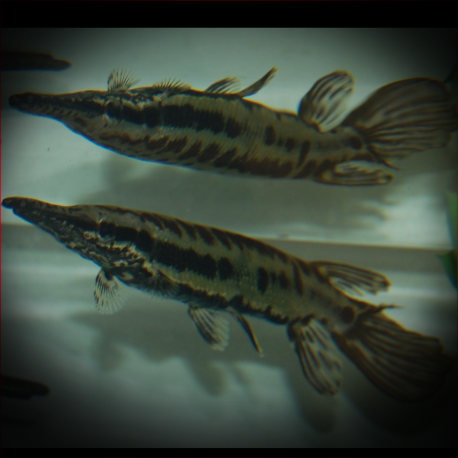More info
Datasheet
| Minimum Tank Size | 10000 litres / 2641.72 US gallons |
| Maximum Size | 125.0cm / 49.21inches |
| Temperature | 22°C / 71.60°F - 28°C / 82.40°F |
| Hardness | 5.04dgH / 90ppm - 25.04dgH / 447ppm |
| pH | 6.0-8.5 |
General Description
The Tropical Gar (Atractosteus Tropicus) is among the most primitive fish species still in existence today, featuring a modified, vascularized swim bladder that enables it to breathe atmospheric air to a certain extent. This species is not typically suited for home aquariums due to its eventual large size and longevity, but some public aquariums house them long-term and juveniles are sporadically available in the aquarium trade.
Aquarium Setup
The Tropical Gar requires aquarium conditions with moderate water flow and subdued lighting. It is recommended to provide a tank size of at least 10,000 liters (2,642 gallons) for suitable space. Water parameters should ideally be maintained within a temperature range of 22-28°C (71.6-82.4°F), pH between 6.0-8.5, and hardness of 90-447 ppm. Further details on aquarium setup can be found in the provided table.
Behaviour
Best kept alone or with similarly-sized non-aggressive fish that the Tropical Gar cannot fit into its mouth, this species is an ambush predator in nature. It is essential to avoid housing the Tropical Gar with smaller tank mates, as they may be viewed as prey.
Feeding and Diet
Being ambush predators, Gars feed on smaller fishes and aquatic crustaceans in the wild. Encouraging captive individuals to accept dead foods may require patience, with most eventually adapting after a short period of adjustment. Ideally, feed them meaty frozen foods such as prawns or lancefish; large specimens can be offered whole fishes like trout or sprats. It is important to maintain a balanced diet and avoid mammal meats like beef heart, as they may lead to health issues in the long term.
Reproduction & Dimorphism
The Tropical Gar is not typically bred in captivity. In the wild, it moves to flooded wetlands or floodplains during the spring to spawn. Females may spawn with multiple males, depositing eggs among submerged vegetation. The toxic eggs are lethal to crustaceans and vertebrates besides fishes. Larvae attach to submerged surfaces until the yolk sac is fully absorbed.
Habitat and Distribution
Found in various habitats ranging from large lakes and rivers to sluggish tributaries and backwaters, the Tropical Gar thrives in both fresh and brackish waters. Its preference lies in large rivers and swamps with extensive floodplains in the Caribbean and Pacific-slope drainage basins of Central America, spanning from southern Mexico to Costa Rica.

